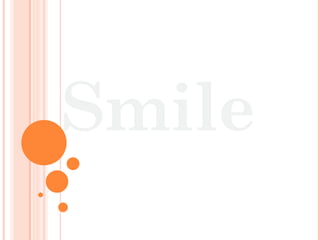
Smile
- 1. Smile
- 2. A smile is a facial expression formed by flexing the muscles near both ends of the mouth. The smile can also be found around the eyes Among humans , it is customarily an expression denoting pleasure, happiness, or amusement, but can also be an involuntary expression of anxiety, in which case it is known as a grimace. Cross-cultural studies have shown that smiling is a means of communicating emotions throughout the world. But there are large difference between different cultures.
- 3. Ծիծաղը դեմքի արտահայտությամբ ձևավորված բերանի երկու ծայրերի մոտ գտնվող մկանների թեքում է: Ծիծաղ կարելի է գտնել նաև աչքերի շուրջը: Մարդկանց շրջանում դա սովորական արտահայտություն է որը նշանակում է ուրախություն, երջանկություն կամ զվարճանք, բայց կարող է լինել նաև հուզմունքի մի պատահական արտահայտություն, որի դեպքում այն հայտնի է որպես ծամածռություն: Միջ մշակութային ուսումնասիրությունները ցույց են տվել որ ժպիտը հաղորդակցմնան միջոց է զգացմունքների աշխարհում: Բայց կա մեծ տարբերություն տարբեր մշակույթների մեջ:
- 4. A smile can also be spontaneous or artificial . Happiness is most often the motivating cause of a smile. Among animals, the exposure of teeth, which may bear a resemblance to a smile, is often used as a display —known as a snarl —or a sign of submission . In chimpanzees, it can also be a sign of fear. The study of smiles is a part of gelotology, psychology and linguistics, comprising various theories of affect, humor, and laughter.
- 5. Ծիծաղը նաև կարող է լինել ինքնաբերաբար և արհեստական: Երջանկությունը ամենա հաճախակի պատճառաբանությունն է ժպիտի: Կենդանիների մեջ, ատամների ոչ պաշտպանվածությունը, որը կարող է ծնել ժպիտի նմանություն,որը հաճախ օգտագործվում է որպես սպառնալիքի կամ զգուշացման ցուցանակ- հայտնի է որպես մռթմռթոց- կամ ներկայացման նշան: Շիմպանզեներիմոտ դա կարող է լինել նաև վախի նշան: Ժպիտի ուսումնասիրությունները լեզվաբանության, հոգեբանության և gelotology մաս են կազմում, կազմված տարբեր տեսությունների հիման վրա ` հումորի և ծիծաղի:
- 10. discoverer of the Duchenne smile. Although many different types of smiles have been identified and studied, researchers have devoted particular attention to an anatomical distinction first recognized by French physician Guillaume Duchenne. While conducting research on the physiology of facial expressions in the mid-19th century, Duchenne identified two distinct types of smiles. A Duchenne smile involves contraction of both thezygomatic major muscle (which raises the corners of the mouth) and the orbicularis oculi muscle (which raises the cheeks and forms crow‘ feet around the eyes). A non-Duchenne smile involves only the zygomatic major muscle. “Research with adults initially indicated that joy was indexed by generic smiling, any smiling involving the raising of the lip corners by the zygomatic major…. More recent research suggests that smiling in which the muscle around the eye contracts, raising the cheeks high (Duchenne smiling), is uniquely associated with positive emotion.
- 11. The end